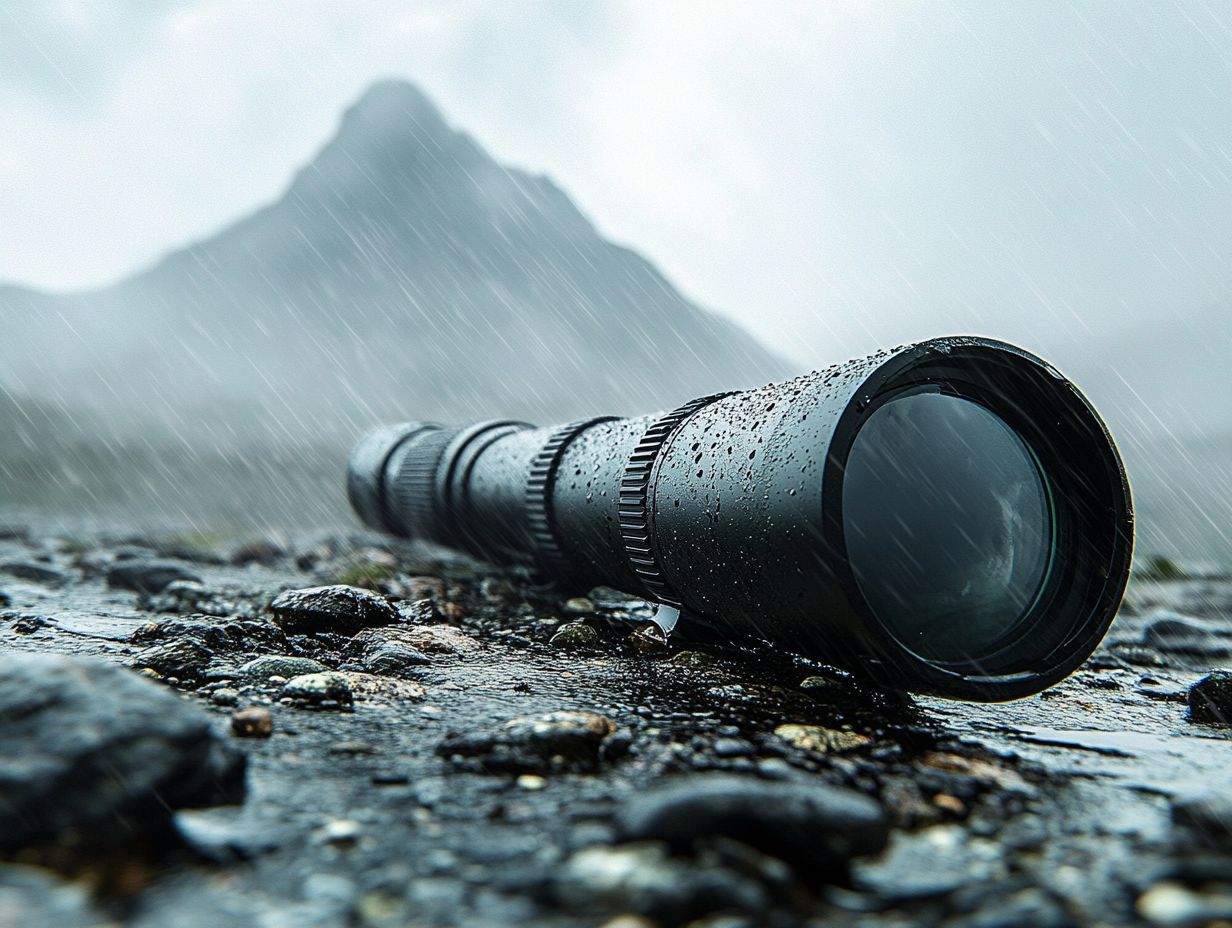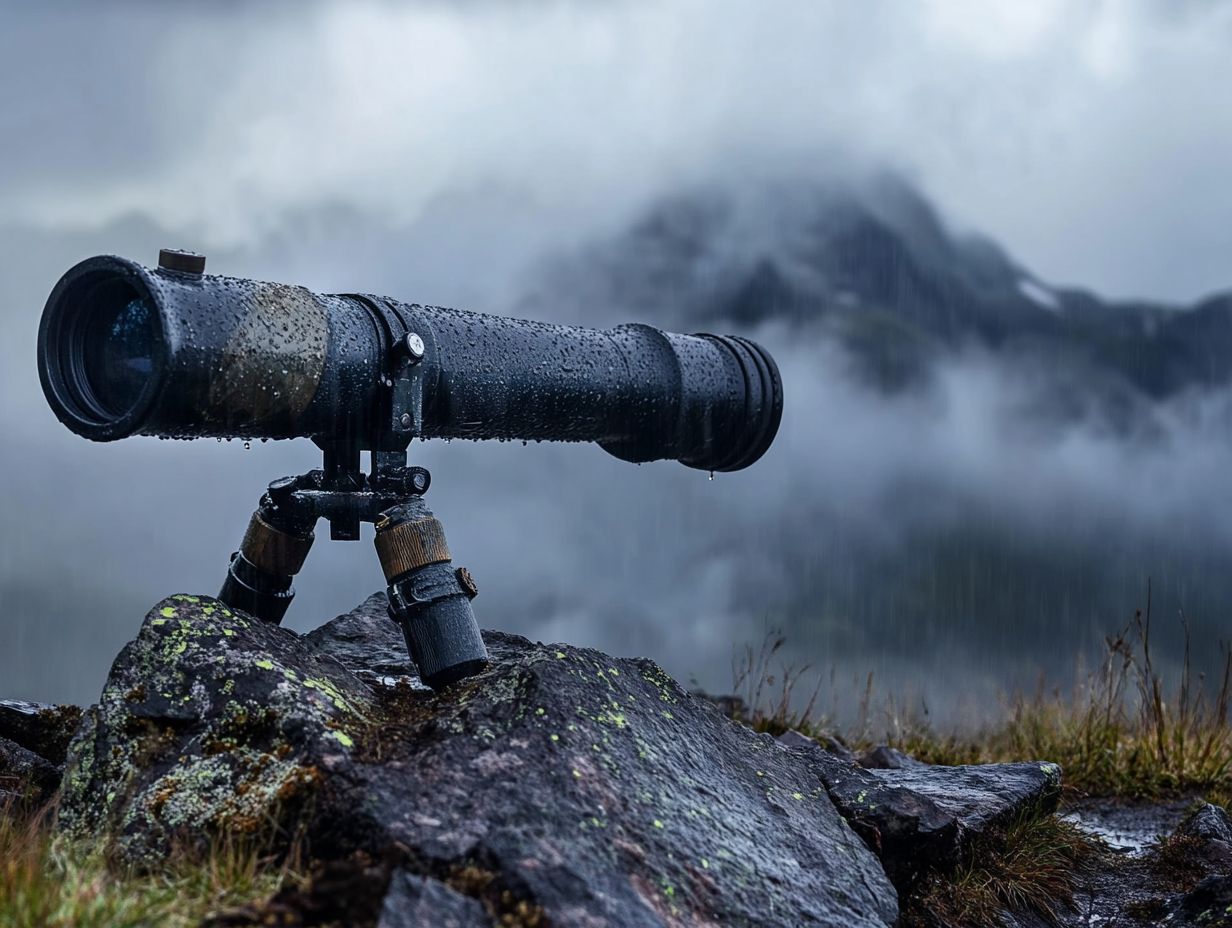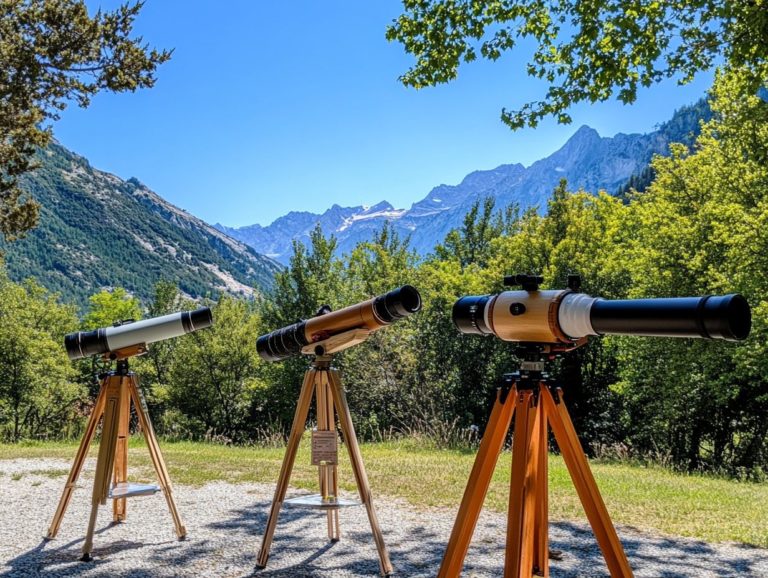How Weather Affects Spotting Scope Performance
Spotting scopes are invaluable tools for you as a birdwatcher, hunter, or nature enthusiast, providing an intimate glimpse into the world of distant subjects, such as birds perched on chimney pots.
You ll find that their performance can vary dramatically with changing weather conditions. While understanding the features and functions of these optical devices is essential, it s equally crucial to recognize how elements like optical quality and weather conditions can affect image clarity and visibility, especially when using advanced technologies like 120x scopes or 190x viewing.
Let s dive into key tips you need to use your spotting scope effectively in any weather! This article delves into essential tips for using spotting scopes in various weather scenarios, along with preventative measures to shield your equipment from the elements. Dive in to ensure you re fully prepared to maximize your spotting scope experience, whether you’re indoors looking through kitchen double glazing or outdoors in fresh air, regardless of the conditions!
Contents
- Key Takeaways:
- Understanding Spotting Scopes
- Factors Affecting Spotting Scope Performance
- How Weather Affects Spotting Scope Performance
- Tips for Using Spotting Scopes in Different Weather
- Protecting Your Spotting Scope from Extreme Weather
- Frequently Asked Questions
- How does the magnification level (9x) of a spotting scope affect its performance?
- What impact does the objective lens size (4mm) have on spotting scope performance?
- How does the exit pupil (8mm) affect the performance of a spotting scope?
- Can weather conditions affect the performance of a spotting scope?
- What role does the eyepiece (6mm) play in the performance of a spotting scope?
- How do different types of weather conditions (e.g., sunny vs. cloudy) affect the performance of a spotting scope?
Key Takeaways:

Weather can greatly impact the performance of a spotting scope, affecting image clarity and visibility. To optimize your experience, it’s important to know how to adjust your spotting scope for different conditions.
To optimize performance in different weather conditions, adjustments may need to be made, such as increasing magnification to 100x limit or using lens coatings to enhance clarity.
Proper maintenance and protection of your spotting scope can help prevent damage from extreme weather and ensure its longevity.
Understanding Spotting Scopes
Spotting scopes are advanced viewing tools that elevate your viewing experience, offering enhanced magnification and clarity for observing distant subjects. They are essential for activities such as birdwatching, planetary observations, and hunting.
With a variety of options available from 12×50 binoculars to cutting-edge Dall Kirkham refractors these tools meet a wide range of viewing needs. Choosing the right spotting scope can dramatically enrich your experience, particularly when gazing at celestial bodies like Jupiter or Mars through a well-coated lens designed to deliver impressive resolution.
Whether you re watching birds nestled on chimney pots or scanning the horizon, grasping the features and functions of spotting scopes is vital for getting the most out of your observations.
Factors Affecting Spotting Scope Performance
Grasping the numerous factors that influence spotting scope performance is crucial for elevating your viewing experience, whether you’re observing birds from your kitchen or gazing at celestial bodies through a south-facing window.
Key components include the optical quality of your scope, shaped by elements like lens coatings and the specific type of glass employed. External weather conditions affect how clear and visible your images are, influencing everything from faint unwanted images to the stability of thermal stresses on the optics.
Knowing these details helps you enjoy your observations more, whether you are using a 120mm refractor or simple binoculars.
Optical Quality
Optical quality is a crucial factor that directly impacts your experience with spotting scopes, influencing how clearly and accurately you can observe distant subjects. When you opt for high-end models, such as the 8 inch Maksutov, you often benefit from advanced lens coatings that minimize glare and maximize light transmission, significantly enhancing resolution in good seeing conditions.
On the other hand, settling for low-quality optics can lead to frustrating faint images or chromatic aberrations, detracting from your overall viewing pleasure.
These lens coatings are essential for enhancing contrast and brightness, ensuring that every detail remains sharp, even in challenging lighting conditions. Premium spotting scopes utilize various types of glass, such as extra-low dispersion (ED) and high-density glass, to reduce distortions and improve color fidelity.
When these materials are paired with quality coatings, they create a synergy that delivers exceptional optical performance.
If you want to spot wildlife or enjoy birdwatching, investing in a quality scope is essential. This can dramatically elevate your observational experiences, making every detail more vivid and true to life.
Weather Conditions
Weather conditions play a significant role in your spotting scope performance. Factors like temperature, humidity, and air pressure can influence both the optics and the atmosphere you’re observing through. In colder temperatures, temperature changes can lead to fogged lenses. High humidity can create distortions that obscure fine details.
Understanding these conditions helps you make informed choices when planning your observations. Adjust your equipment for the best results by using a dew shield or opting for a heavier tripod for stability.
To enhance your spotting scope experience, consider using anti-fogging solutions or lens covers to combat condensation in cooler climates. If you find yourself in high humidity, choose a scope equipped with a nitrogen purge a method that keeps the inside of the scope dry and clear. This will help prevent internal fogging and keep your view clear.
When faced with brisk winds or storms, stabilizing your scope on a sturdy tripod can minimize vibrations and shake. This ensures a sharper view of distant subjects, especially when tracking a faint, diffuse comet. Protect your gear from rain or snow with waterproof cases. This will not only prolong its lifespan but also maintain image quality, allowing you to adapt and enjoy your outdoor observations no matter the weather.
How Weather Affects Spotting Scope Performance

The effects of weather on spotting scope performance are quite complex. They impact everything from image clarity to overall visibility during your observations. Factors like air movement, humidity levels, and temperature fluctuations can significantly affect your scope’s ability to perform as intended.
When you’re aiming for planetary observations or trying to catch a glimpse of faint, diffuse comets, it’s crucial to adjust your setup based on the current weather conditions.
Impact on Image Clarity and Visibility
The impact of weather on image clarity and visibility is crucial for you as a spotting scope user. This is particularly important when engaging in critical observations of celestial bodies like Mars or Jupiter.
Elements such as air movement, moisture levels, and cloud cover can significantly influence your viewing experience, especially in cold weather optics or through a single pane window. For example, on humid nights, the water vapor in the air can scatter light, resulting in frustrating blur.
Consider choosing cooler, drier conditions, which typically provide sharper images. Strong winds can also introduce instability, making it tricky to lock in on your target. Investing in a sturdy tripod or simply waiting for calmer moments can greatly improve your stability.
When clouds decide to play hide-and-seek with celestial objects, a little strategic planning around weather forecasts can ensure you seize those optimal viewing opportunities. Don t miss out on the perfect stargazing opportunity!
Adjustments to Make for Different Weather
Making the right adjustments to your spotting scope based on weather conditions can significantly enhance its performance. This ensures you enjoy optimal viewing experiences, whether you’re tracking a faint, diffuse comet or gazing at the intricate features of Jupiter through a 120x scope.
Consider adjusting the focus settings, stabilizing the scope against wind, or using a protective cover to mitigate temperature changes that can arise from fluctuating conditions. Understanding these modifications is essential for maximizing the effectiveness of your spotting scope.
On breezy days, opting for a heavier tripod can provide added stability, helping to minimize vibrations that might compromise clarity. When humidity levels rise, a dew shield can be invaluable in preventing moisture from building up on the lenses, especially during cold weather or when using modern double glazing at your kitchen window.
Keeping the optics clean and free of dust will enhance visibility and improve light transmission during overcast conditions. It s also a smart move to regularly check the forecast. Sudden changes can require quick adjustments, ensuring you re always prepared for clear and stunning astronomical observations, including the Sun 20 degrees or at 30 degrees elevation.
Get ready for your next observation adventure check the weather and prepare your gear!
Tips for Using Spotting Scopes in Different Weather
Using spotting scopes effectively in diverse weather conditions demands more than just familiarity with the equipment; you must adapt and make real-time adjustments that align with your environment.
Whether you’re contending with the chill of cold weather optics or grappling with high humidity, a collection of strategic tips can help you sustain peak performance. By selecting the right lenses and fine-tuning your stance for enhanced stability, you can significantly elevate your viewing experience.
Best Practices for Optimal Performance
To achieve optimal performance with your spotting scope, it’s essential to understand both your equipment and the environmental conditions that influence your observations, such as temperature changes in 150x cold temperatures.
Regular maintenance is key; ensuring that lens coatings remain intact is crucial. Familiarizing yourself with the specific characteristics of your spotting scope will help you maximize image clarity and minimize the effects of adverse weather.
Adapting to changing weather is vital for enhancing your viewing experience. Knowing how to clean your optics after moisture exposure will help prevent grime and scratches.
Utilizing protective covers can shield your equipment from unexpected rain or dust while you’re outdoors. Understanding how temperature changes affect optical performance is important; allowing your scope to acclimatize to outside conditions can significantly reduce fogging issues.
Ultimately, gaining a thorough understanding of your spotting scope will not only prolong its lifespan, but it will also enhance your observational success, regardless of the environmental challenges you encounter.
Protecting Your Spotting Scope from Extreme Weather

Protecting your spotting scope from extreme weather is vital to keeping it in top shape, particularly when facing challenges like frigid temperatures, elevated humidity, or harsh sunlight.
Implementing proactive measures is essential whether that means proper storage, utilizing protective cases, or performing regular maintenance to keep your optics in peak condition.
By grasping the specific needs of your equipment, you can effectively mitigate potential weather-related issues and ensure your spotting scope remains reliable in any environment.
Preventative Measures and Maintenance
You must take proactive steps and maintain your spotting scope to keep it performing well over time, especially when confronted with varying weather conditions. This includes routine cleaning of lens coatings to prevent moisture or dust buildup, as well as using protective covers specifically designed for extreme weather.
To further safeguard your equipment, consider employing moisture-absorbing materials within your storage cases to help control humidity levels and prevent internal fogging. Regularly inspecting seals and gaskets for wear is crucial to ensure that moisture doesn t seep in during unexpected rainfalls.
When transporting your scope, do so with care using padded cases will help protect against physical shocks. When not in use, store your spotting scope in a dry, temperature-controlled environment to mitigate risks associated with temperature fluctuations and humidity.
Collectively, these strategies will contribute significantly to maintaining the integrity of your optics and ensuring long-term usability.
Equipment Storage Solutions
Proper equipment storage solutions are essential for preserving the condition and functionality of your spotting scope, especially when faced with extreme weather conditions.
Did you know that selecting the right storage options can significantly enhance your equipment’s longevity? Investing in high-quality protective cases not only shields against physical impacts but also acts as a barrier against environmental factors.
Airtight containers fitted with dehumidifiers are particularly advantageous for those in humid climates, as they effectively manage moisture levels, preventing mildew and corrosion.
Creating dedicated storage areas that regulate temperature can lead to more consistent performance and reliability when it’s time to venture outdoors. Understanding these solutions will help you keep your equipment performing well throughout its use.
Frequently Asked Questions
How does the magnification level (9x) of a spotting scope affect its performance?
The magnification level of a spotting scope tells you how many times larger an object will appear compared to the naked eye. Higher magnification levels, such as 9x, can make it easier to spot small details and identify faraway objects. However, they can also make the image shakier and decrease the field of view, making it more difficult to track moving objects.
What impact does the objective lens size (4mm) have on spotting scope performance?

The objective lens size refers to the diameter of the front lens. A larger objective lens, such as 4mm, allows more light to enter the scope, resulting in a brighter and clearer image. This is especially useful in low-light conditions.
However, a larger objective lens also means a heavier and bulkier scope, which may not be ideal for certain situations.
How does the exit pupil (8mm) affect the performance of a spotting scope?
The exit pupil is the small circle of light you see when you hold the eyepiece of a spotting scope at arm’s length. It’s determined by dividing the objective lens size by the magnification level. An exit pupil of 8mm is considered optimal for most lighting conditions. This allows for a bright and clear image, but if the exit pupil is too small, the image will appear dim and difficult to see.
Can weather conditions affect the performance of a spotting scope?
Absolutely! Weather conditions such as rain, fog, and extreme heat or cold can greatly influence the performance of a spotting scope. Rain and fog can obscure the view and decrease image clarity, while extreme temperatures can cause the optics to fog up or freeze. It is important to consider the weather conditions when choosing a spotting scope and to take precautions to protect it when necessary.
What role does the eyepiece (6mm) play in the performance of a spotting scope?
The eyepiece is the part that you look through to see the image. It allows you to adjust the focus and magnification. A higher quality eyepiece, such as one with a 6mm focal length, can greatly improve the image quality and clarity. Choose an eyepiece that is compatible with your spotting scope for optimal performance.
How do different types of weather conditions (e.g., sunny vs. cloudy) affect the performance of a spotting scope?
The type of weather can significantly impact the performance of a spotting scope. In sunny conditions, the image may appear brighter and colors more vibrant, while in cloudy conditions, the image may appear duller and harder to see. It’s crucial to select a spotting scope with appropriate coatings and features, such as anti-reflective coatings, to enhance image quality in different weather conditions.






